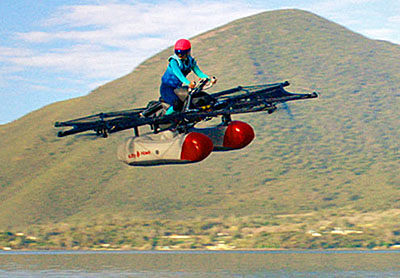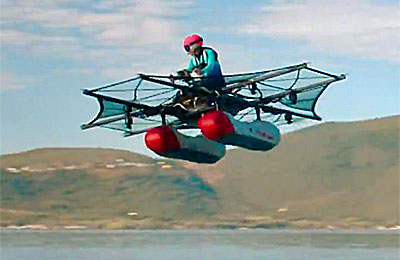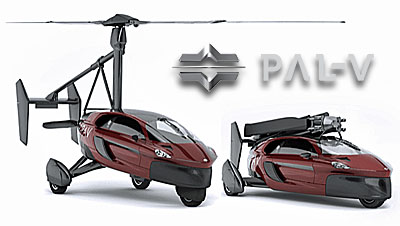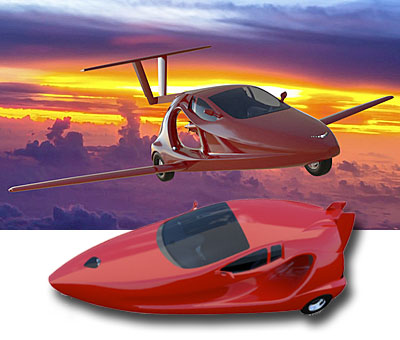
One glance at the images tells you this is no “flying car,” as no car is involved. More accurately, Kitty Hawk’s Flyer is an ultralight vehicle in the water thrill craft or all-terrain vehicle category … making it sort of one of “ours,” if I’m permitted to stretch the possessive.

Like it or not, airplane building is becoming more an information technology. Wings, props, and stability still must follow the laws of physics but these alternative aircraft, these “copter aircraft” don’t look like the ones recreational or sport pilots fly today. They don’t operate the same either.
In early test flights, aerospace engineer, Cameron Robertson, worked two joystick-like controls to pilot Kitty Hawk above Clear Lake. His initial flight rose only 15 feet above the water, circled over the lake not far from from shore, and landed after about five minutes on a floating landing pad at the end of a dock (video below).

Pal-V is a gyroplane concept flying vehicle.
The Kitty Hawk company wants to be one of the first on the market and plans to start selling its vehicle by the end of the year …yes, this year (2017). However, they caution, “The go-to-market Flyer will have a different design than the prototype Flyer that appears in our April 2017 photos and videos.”
One unusual response from the company. You might not even think to ask, but can Flyer be flown over land? “No. The Flyer is designed to be flown over fresh water,” they said.
Kitty Hawk Flyer is one of several prototypes the Mountain View, California company is developing. They hope to appeal to enthusiasts and hobbyists willing to pay $100 for a three-year “membership” with several benefits including a $2,000 discount on the retail price of a Flyer.

Samson‘s Switchblade brings conventional wings inside the vehicle.
Readers of this website recognize that, given its specs (such as we know at this time), Kitty Hawk’s Flyer can operate under FAR 103 and the company acknowledges use of this regulation. As with all Part 103 vehicles, no pilot license, no medical, no registration, and no N-numbers are needed. It can be sold ready-to-fly. You must steer clear of controlled airspace without ATC permission, avoid congesteded areas and a few other things, but the entire 103 regulation can be printed on the front and back of a single sheet of paper.
Thanks, Mike Sacrey (and several FAA associates), for writing Part 103 back in 1982. No one then could predict a company called Google or an aircraft called an octocopter but both are here and the list below shows we’re going to see more flying cars or “copter aircraft.”
Recommended — A website I often visit, unrelated to aviation, had some good words to say but also a collection of 10 short videos about flying car/weird flying machine projects. I recommend you check this article out at least for the videos. If you can’t wait, following is a very short clip of Kitty Hawk flying.
Flying Car Developers
More than a dozen companies — several of which have been covered on this website — are presently in development, including:
- AeroMobil
- Airbus Group
- EHang
- Haynes Aero
- Joby Aviation
- Kitty Hawk
- Lilium
- Moller International
- PAL-V
- Sky Runner (was Parajet)
- Samson Motorworks
- Terrafugia
- Uber
- Volocopter
- Xplorair


Jetson? …or Luke Skywalker’s “speeder” ground-effect, hover craft-type flyer.
Everything was new at one time or another and had a “first.”
Will
Hi Dan, Google’s Larry Page Building an Ultralight? Yes! This does not meet Part 103. While it is less than 254 lbs it does not meet the stall requirement etc.. . The FAA has there hands full with these types of gadgets being called Ultralights. In order to meet Part 103 it must meet all the requirements, not just one. Jet packs and such are going to force FAA to take action, and I hope they don’t just scrap 103.
Urge these people to do the right thing! Ed Pitman
Thanks for your observations, Ed. You are correct, of course, about the need to meet more than the maximum empty weight to qualify as a Part 103 vehicle. The stall speed parameter of Part 103 seems impossible to confirmin an octocopter. The company line is that Kitty Hawk was in contact with FAA about meeting 103, although most readers know FAA folks are often not very knowledgeable about these lightest of powered aircraft. One thing you are absolutely right about and which is a concern is that these new “alternative” aircraft should not cause problems for Part 103. That simple regulation has endured since the early ’80s and many of us would like it to remain as it is for many more years.